Tour Guide
Belgrade Grand Tour
- 12 Hours
- 1-8 People
- Leisurely Walking Pace
Kalemegdan.
After we pick you up from your hotel, it won’t take us long to reach our first stop. This will be the Kalemegdan park, the most beautiful and the most popular park in Belgrade. In order to reach the Belgrade fortress, we must pass through this park and along the way enjoy the attractions that it generously offers. We will pass by the monument that symbolises gratitude to France (“À La France”, created by the most famous Yugoslav sculptor, Ivan Meštrović) and then head towards the gate that will lead us into the fortress.
Belgrade Fortress.
The site at which Belgrade came to be more than 2000 years ago is the perfect place to start our tour. During what is approximately a 45-minute walk, you will hear wonderous stories about Belgrade’s exciting history, pass by the original Singidunum fortifications and then through the Stambol gate, which it is the beginning of the road that connected Belgrade (then Singidunum) to Constantinople (now Istanbul), in order to reach the Upper City and then head towards the symbol of Belgrade, the Monument to the Victor.
Monument to the Victor (Pobednik).
The monument to the victor, another work of Ivan Meštrović, stands at the main plateau of the Belgrade fortress, from where you will get a magnificent outlook over the entire city, the confluence of the rivers Sava and Danube, and the Great War Island in the middle. After a photography break, we will move along the other side of the fortress, passing by the Roman Well, the mausoleum of Damad-Ali Pasha, the military bunker, and finally through the King’s gate, leaving the fortress and heading towards Knez Mihajlova Street.
Knez Mihajlova street and The Republic Square.
Walking through Knez Mihajlova Street, which is the most beautiful and oldest street in Belgrade, we will get to enjoy the beautiful architecture from the end of the 19th century, intricately decorated facades inspired by the secession movement, and French-style balconies. We will see the remains of the old Roman way that led through this street, proving that it is, in fact, almost 2,000 years old. At the end of the 750m-long street lies the largest square in Belgrade – the Republic Square. It is dominated by the monument to Knez (Prince) Mihajlo, which is surrounded by the National Museum and the National Theatre. From this point on, we continue the tour by car.
Pass by Terazije.
The tour moves us along to Terazije square, where we make a brief stop by the most elegant hotel in Belgrade, the Moskva (Moscow) hotel, built in 1906 and famous for its Moskva Schnitt cake. This hotel is a typical example of Belgrade’s Art Nouveau architecture. Across the square of Nikola Pašić, which is Belgrade’s second largest square dedicated to the late-19th-century Prime Minister of Serbia, who was also the founder of Serbia’s first political party, we make our way towards the Serbian National Assembly Building.
The National Assembly Building.
We will make a quick stop by the Serbian National Assembly building, which, interestingly, has served as the parliament building of 9 different countries from the moment it was built until today. Across the street, you can spot the old and the new court of the Kingdom of Serbia, which are nowadays used as Belgrade City Hall and the Residency of the Serbian President.
The ruins of army and police headquarters.
After entering Kneza Miloša street, one of the main Belgrade arteries, also known as Embassy street, we will pass by a series of buildings that were destroyed in the NATO bombing of 1999. These buildings stand today as stark reminders and unofficial monuments. Further on, we will pass by several main governmental buildings–the Ministry of Finance, and the Ministry of External Affairs–as we continue our tour, towards the House of Flowers.
House of Flowers.
Originally a winter residence of president Tito, it today serves as a mausoleum of the President of second Yugoslavia. In addition to visiting the mausoleum, in which we will see an interesting exhibit dedicated to Josip Broz Tito and the Relay of Youth, we will also enter the old museum, which houses a selection of gifts that Tito received from foreign dignitaries during his 35-year-long presidency.
Pass by Dedinje.
The tour moves along through Dedinje, the most luxurious part of the city, where you will see glamorous villas in which the today’s elite of Belgrade lives, all neatly tucked into the greenery of Topčider hill. Here, the guide will give you some interesting insights into the happenings within these estates after World War II, during Communist rule, in contrast to how they are run today. We will also pass by “Marakana”, the stadium of Crvena Zvezda (Red Star), the greatest football club in the Balkans who have won both the European and the World football crown at their peak. The name of the stadium is taken from its Brazilian counterpart, due to its formidable size.
Saint Sava’s Temple.
Coming from the direction of Dedinje, we will climb the Vračar hill in order to reach what is possibly Belgrade greatest attraction–the Temple of Saint Sava. The temple is built on top of the hill, which is 52m about sea level and therefore dominates the Belgrade panorama. Built in a mix of Serbian and Byzantine styles, the temple itself is 82m tall, its dome is 70m tall, and on its top is a gilded cross 12m tall. The temple covers 3500 square metres, and when we add to that 1800 square meters of the crypt and the upper galleries that can accommodate 800 choir members, we understand that the temple has the capacity to receive more than 12,000 believers, which makes it one of the largest Orthodox temples in the world. But even if we disregard its size, the temple remains impressive. It took almost a century for it to be built, but the way that it looks today justifies this duration. With a mosaic that weighs 40 tons, and 24-carat gilt on the facades in the crypt, the temple is simply stunning. It is dedicated to Saint Sava, the “father” of Serbian people, the person the Serbian people recognize to be the most important figure in their history, the founder of the Serbian Orthodox Church, and its first Archbishop. The temple was built at the spot where his relics were burnt in 1595 by the Ottomans. After taking a closer look at the temple, we will take a lunch break in a traditional Serbian restaurant (optional).
Avala mountain.
Next we leave the city and head towards Avala, a mountain overlooking Belgrade and one of the townsfolk’s preferred picnic places. Driving through the lush green forest, we reach the 511m tall mountain on top of which stands one of the symbols of the city – the Avala Tower. This tower was built in the 1960s, as a telecommunications tower and, at the time of its creation, was the largest and tallest concrete building in the Balkans. It was bombarded and destroyed in 1999., but an identical one was re-built in its place ten years after the bombing. One of the two elevators it has will take us upward, to a gallery that is 123 metres high and reveals a spectacular view over the entire city and its surroundings, a view that can be enjoyed even more with the help of binoculars that will be at our disposal.
Monument to The Unknown Hero.
Near the Avala tower stands one of the most well-known Serbian monuments, the Monument to The Unknown Hero, yet another work of Ivan Meštrović. Dedicated to the victims of the Balkan wars and World War I, sculpted from black marble, featuring colossal sculptures reminiscent of ancient tombs, this monuments sparks controversy, respect, and awe.
Pass by Novi Beograd.
As we return from Avala, we head via the E-75 highway, originally built as the highway of Brotherhood and Unity that connected all six republics of former Yugoslavia, towards new Belgrade, which is an entirely different part of the city. It is precisely the part that was built in its entirety after World War Two, when the Communist government dried out the swamp that was originally there and erected a settlement that was supposed to represent a new era, which is today the most densely populated part of Belgrade and Serbia. We will take you by the buildings of the former Central Committee and the Federal Executive Council, the Genex tower (which was once the tallest building in Belgrade but is today abandoned due to bankruptcy), as well as the largest entertainment arena in this part of Europe, next to which is one of the most famous restaurants in our country–the Novak restaurant. New Belgrade will let you observe yet another facet of the city: its brutalist architecture, its repetitive, massive, and uniform buildings, which have been recognised by the MOMA museum in New York that dedicated a special exhibit to it, entitled “Toward a Concrete Utopia”.
Zemun.
After passing through New Belgrade, we arrive to a part of the city called Zemun. Zemun is on the other bank of the Sava river, meaning that it lies in Central Europe, as its architecture and style reflect. After passing through the center of Zemun, where you can see the Aviator square, the main Post Office, the town museum, etc., we arrive at the heart of Zemun, the Old Town renowned for its cobblestones, the authentic spirit of 19th century that it tries hard to maintain, and numerous riverside fish restaurants. Until the end of World War I, Zemun was part of Austria-Hungary, and is therefore entirely different from Belgrade, even though it is now a part of it. After a walk through the Old Town, we will reach the top of a hill where there is the millennium tower – Gardoš. In 1896, when the Hungarians were marking a one-millennium anniversary of their arrival into Europe, Gardoš was the southernmost point of Hungary, and today it is the spot from where you can enjoy a beautiful view of Zemun, Belgrade, and the Danube river.
Back to your hotel.
At this point, our tour concludes, and we will bring you back to your accommodation.
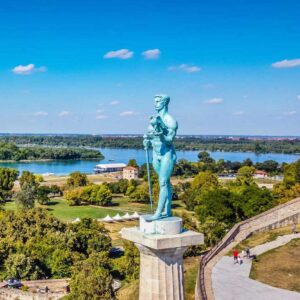
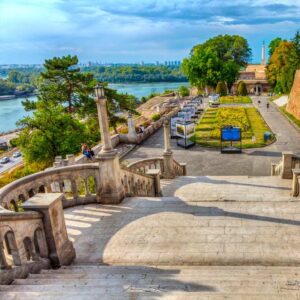
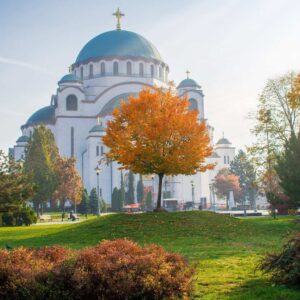
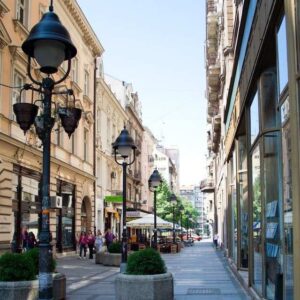
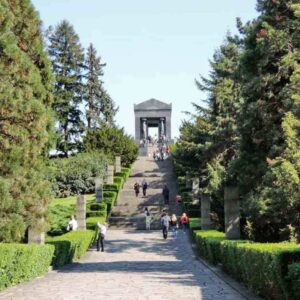
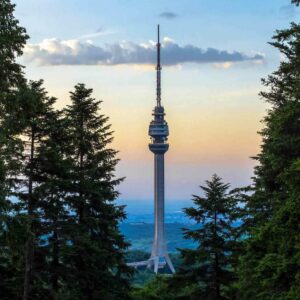
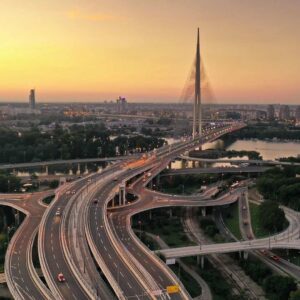
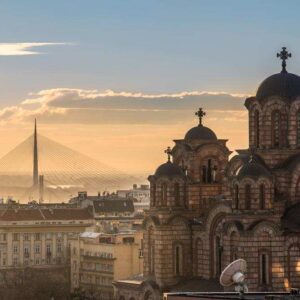
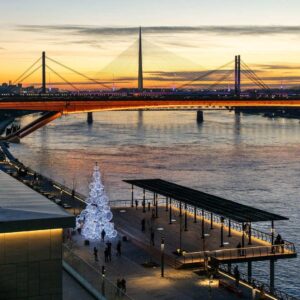
Tour includes
- Hotel pick-up and drop-off
- Certified-Serbia Guide
- Refreshments
Tour excludes
- Gratuities for your guide
- Tickets
- Meals
- Individual expenses
Questions about this tour?
Send us a message using the form below and we’ll get back to you within 24 hours.